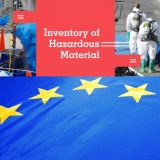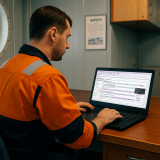In the hazmat world today, most large organizations follow a time-honored process for identifying critical compliance needs and spend the money necessary to make it work. It is a process that tilts the compliance board in advantage of the bigger players.
It starts with a sophisticated purchasing or procurement system, usually with a module that enables environmental health and safety (EHS) staff to review and approve all incoming hazardous items. Nothing arrives into a big company unnoticed. Next, the chemical or product is tracked through some type of bar code or RFID-tagged inventory management system, and data on its location and specific usage is recorded.
Material safety data sheets (MSDSs) are obtained and tracked, using a sophisticated document and data management system that is tied into procurement and chemical tracking. At the end of all this, compliance reports required by EPA and local agencies are generated and submitted, usually electronically. At this point, management plans are made or modified, staff are trained or retrained and the company moves forward safely until the next monthly review period.
This utopian view of compliance management has been practiced for so long in so many high-profile companies that it has become the de facto process for managing compliance. In the world most EHS managers live in, however, the tools and resources just described do not exist. Companies today are forced to manage hazardous materials with limited budgets, staff, tools and systems.
Today, organizations need to create a new framework that takes into account the whole picture of hazmat compliance and its effect on the organization. Companies need to set their sights and marshal resources in one key area – an accurate hazmat inventory.
The picture begins with an accurate, up-to-date inventory of the pure chemicals, mixtures and products within the organization. The inventory becomes the foundation upon which the company manages other critical data and turns that data into knowledge on the hazards present in each of its facilities. This knowledge, when applied on a geographical, functional and hierarchal level within an organization, helps EHS staff make better business decisions.
This increases the value of the organization by reducing risk, cost and liability. A good hazmat inventory improves the bottom line and the basics are easy to understand and implement.
The Inventory
How Often? The frequency with which an inventory should be reviewed will depend on the size of the business and number of locations/departments that contain hazardous materials, the sophistication of purchasing and approval processes and the expected turnover of chemicals and other hazardous materials.
In an ideal world, a master inventory should be taken at least annually by the person responsible for the inventory in a specific location/department. Each new purchase or disposal should be tracked and the inventory modified throughout the year. EHS supervisors at each facility should have pre-purchase review and approval rights for any new product or chemical. Inventories from separate locations within an organization should be rolled up into a corporate-level inventory for analysis and to ensure consistency in process and purchasing.
What Data to Record? At a minimum, the location of each product or chemical should be recorded as well as the container size and quantity on hand of the material, the name of the product or chemical, the name of the company that made the product or chemical and any part number or description assigned by the manufacturer. This basic data will enable EHS staff to match the item to an MSDS, which can provide all the critical data needed for reporting and exposures.
Problems: The staff conducting the inventory may come across unlabeled, illegible and secondary labeled containers. Record these items in a separate discrepancy document, with their specific location and description, then physically flag the item itself, with stickers, labels or string that is easily visible. Review the discrepancy document at the completion of the inventory process to determine appropriate actions such as re-identifying products with appropriate labels and/or removing products from the facility.
Completing the Picture
Once an accurate inventory is obtained, it is possible to begin to add value to each record by associating other data, documents or records with each inventory item and supporting this information with on-site EHS staff or outside resources to assist employees in use and interpretation. This is an important step in seeing the “whole picture.”
MSDSs: Associate each item in the inventory with a manufacturer-specific MSDS and keep the inventory list and MSDS available for easy access by employees. The MSDS provides vital information for exposures and the specific characteristics of the chemicals in a product or mixture. Many companies keep the inventory list and corresponding MSDS in a file – hard copy or electronic – forever to meet OSHA’s exposure record keeping requirements. A process for obtaining new or updated MSDSs will be required as products change, or MSDSs go out of date.
Classification: Assign each item in the inventory a National Fire Protection Association (NFPA) and Hazardous Materials Identification System (HMIS) rating and classify the item for common modes of transport. NFPA has a system for identifying the hazards of a chemical that was developed with the needs of fire protection agencies in mind. The local fire department may require this information be provided along with the chemical inventory.
The HMIS rating is a labeling system developed by the National Paint and Coatings Association to quickly identify the hazards associated with a certain material. Inventory items should also receive a classification based on how the item is shipped, whether by ground, air or vessel. Each mode requires a different classification based on the size and quantity of the chemicals being transported.
Further instructions also will be needed on how to properly package different types of hazardous materials, what marking and labels go on the package, which placards go on the vehicle, how to complete the required shipping documentation and who to call in a transport emergency.
Why is the inventory so important? Because with so many companies doing it so poorly, a company that does it right gains a significant strategic advantage. When analyzed, the size and diversity of hazardous products within an organization is almost always a surprise. EHS staff and managers have not seen the “whole picture” and the result is misguided programs, misleading reporting, insufficient training and poor decision-making.
The accuracy of the inventory has cascading affects within an organization, from specific EHS responsibilities to employee well-being, management decision-making and corporate responsibility. If even 10 percent of your inventory is inaccurate, the following issues may arise:
MSDS Compliance – MSDSs will not always be available when needed, or when reviewed may contain outdated information. Staff may be spending valuable time and resources acquiring and maintaining MSDS for products that are not used or stored on site. At the same time, if a company uses its MSDS files as its 30-year exposure record, it could include chemicals and products that were not actually used, thus increasing the company’s potential liability.
Chemical Exposures – On-site data may not be available for the chemicals to which an employee is exposed. If the data is provided, it may refer to a previous or generic version of the product, increasing the likelihood of mistreatment.
Disposal of Hazardous Waste – The designated budget for disposal costs may be inadequate if there are items being used and disposed/recycled that the company is unaware of. Contingency planning for emergency response will be incomplete.
Regulatory Reporting – Sensitive chemicals (such as those that appear on SARA 302 Extremely Hazardous Substances List) may be excluded from required reporting. Items listed on the inventory but not actually used or stored on site could trigger higher reporting thresholds and unnecessarily lead to higher fees related to the amount reported.
Training and Preparedness – An incomplete inventory can hamper employee awareness of the chemicals in their workplace. This significantly increases the risk of exposure or injury and the related cost of treatment. Lack of related inventory data, such as MSDS and storage quantities, also can mean that all hazards are not properly evaluated.
Similarly, if a company assumes that the inventories at all sites or departments within its organization are the same, the following issues may arise:
MSDS Compliance – Site-specific MSDSs are not immediately available, in another building or office, or are completely unavailable. In a true emergency, such as ingestion, inhalation or exposure, treatment information contained on the MSDS will not be accessible by responding personnel. The company is then out of compliance with the Hazard Communication standard, which requires access to MSDSs for employees, with no barriers. This exposes the organization to the most commonly cited OSHA violations.
Chemical Exposures – If a company is unaware of the specific hazards at a given site or within a department, it may not be prepared to respond to employee exposure or injury. In addition, it may not have proper personal protective equipment, eyewash stations or containment tools in place for the specific chemicals used or stored at a site.
Disposal of Hazardous Waste – Established processes for handling specific waste streams may not be adequate. This could lead to waste on site, and the related risk and cost, longer than necessary. Uncertainty about what exactly is in a company’s waste stream may result in using waste contractors that do not have proper training, certification, tools and insurance to properly handle its needs. This applies to its staff as well, who may not have the training and tools to manage the waste they are generating.
Regulatory Reporting – Using a “master” report based on one location as representative of all locations may cause some chemicals to be reported unnecessarily. This could also trigger additional local or state reporting and their associated cost. The reverse also is true: A “master” report could leave some chemicals unreported, increasing risk and opening the company up to potential fines for not reporting the true on-site chemicals.
Training and Preparedness – Without an understanding of the exact nature of the hazards at a specific location, proper training will not be possible. Locations where the amounts of hazards have been underestimated will not have enough training. This is amplified in situations where substances that require unique handling procedures, such as lead and mercury, are found on site. Overtraining also can occur, which unnecessarily increases training cost.
Simply starting with an accurate inventory can result in more wins under your belt. By focusing efforts on gathering and analyzing the right information, EHS personnel can impact the cost for their organization to acquire, track, store, ship and dispose of hazardous materials and improve the understanding of hazardous materials among the employees throughout the organization.
EHS departments are winning every day because they are looking at the right data and making good decisions. Strive to become one of them.
Jess Kraus is the founder of the 3E Co. of Carlsbad, Calif. For more information, visit http://www.3ecompany.com.







